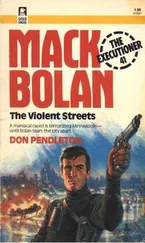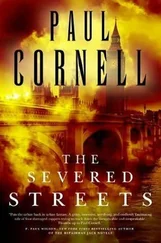“Don’t keep him out too late,” says the desk sergeant. “It’s a school night.”
An old station house line, and Edgerton doesn’t laugh. The fat kid says nothing for a moment, then manages a sentence that is more of a statement than a question:
“You want to talk to me about Pete, too, man.”
“I’m the one who’s gonna talk to you for real,” says Edgerton, walking his prisoner out the booking area door and into the back seat of the Cavalier. Heading west on Lombard Street, Edgerton makes a point of gesturing toward the medical examiner’s building at the intersection of Penn Street.
“You want to wave to your friend?”
“Who’s my friend?”
“Pete. The boy from Payson and Hollins.”
“He ain’t my friend.”
“No, huh?” says Edgerton. “So I guess you don’t want to wave to him?”
“Where he now?”
“Right there. The white building.”
“What’s he doing there?”
“Not a helluva lot,” says Edgerton. “That’s the morgue, yo.”
The detective checks the rearview mirror and satisfies himself that there isn’t a trace of surprise in the fat kid’s face. He’s been locked up at the Southwest since early yesterday morning, but he knows about the murder.
“I don’t know no more about that shit,” the kid offers after a five-second delay. “Don’t know why you got to take me from the Southwest District to talk to me.”
Edgerton slows the Cavalier to the curb lane, then wheels around in his seat and glares hard at the kid’s dark, bloated face. The kid looks back evenly, but Edgerton can already sense some small kernel of fear.
“You don’t need to know,” says Edgerton coldly, turning back and speeding up again. “We’re going to start over like you never met another cop in your whole life. Just forget you ever dealt with a cop any other time in your life because they ain’t never talked to you like I’m gonna talk to you.”
“You gonna talk to me.”
“You got it.”
“I don’t know shit.”
“You were there,” says Edgerton.
“I wasn’t nowhere.”
Edgerton slows the car and turns around again. The kid actually flinches a bit.
“You were there,” says Edgerton slowly.
This time the fat kid says nothing, and Edgerton drives the remaining six blocks in cold silence. Two hours, the detective tells himself. One hour and forty minutes for fat boy here to tell me everything that happened on Payson Street; twenty minutes to write it up and initial each page.
Predictions don’t mean much in the interrogation room; Edgerton proved as much to himself three weeks ago when he went at his best suspect in the Brenda Thompson killing in a third and final interview. That day, Edgerton went into the box predicting a confession and emerged six hours later with nothing but lies. Still, he can’t help but be optimistic this time around. For one thing, the kid in the back seat isn’t the target but merely a witness. For another, he has managed to collect a drug charge that can be used for leverage. Lastly, John Nathan has no heart; he proved as much a minute ago.
Back at the homicide office, Edgerton shepherds the kid into the large interrogation room, then goes into his monologue. Twenty minutes later, the boy is nodding in semiagreement. In all, it requires a little more than ninety minutes before Edgerton has a viable account of the shooting on Payson Street, an account that conforms to everything he learned at the scene.
By Nathan’s account, Gregory Taylor was indeed burning customers with fake dime bags, then firing the profits into his own arms. Even judged against the fleeting standards of the urban drug trade, this was not exactly a long-term career move. Taylor eventually burned a couple boys from down by the Gilmor Homes, then made the mistake of staying out on the corner too long. The boys came back in an old pickup, jumped on Taylor with rifles and demanded their money back. Sizing up the situation correctly, the victim coughed up two $10 bills, but one customer was still unsatisfied. He opened up with the rifle, chasing Taylor across the intersection, firing one round after another as the victim collapsed on the asphalt. The two gunmen then ran back to the pickup and drove south on Payson toward Frederick.
During the brief interrogation, Nathan gives up real names, street names, physical descriptions and approximate addresses-every last little detail. When Edgerton walks back into the main office, he has everything he needs for a pair of search and seizure warrants.
And yet none of that seems to matter the following morning when the administrative lieutenant-the supervisor who serves as a direct aide to the captain-reads the 24-hour report and learns that Edgerton questioned a witness at the scene without bringing the man downtown. Inappropriate, the lieutenant complains. Irregular. Against standard procedure. Such behavior shows bad judgment, perhaps even laziness.
“What the fuck does he know about investigation?” says Edgerton angrily when Roger Nolan tells him of the complaints on the following midnight shift. “He sits in that office and does arithmetic. When did he ever get out on the street and work a case?”
“Easy, Harry. Easy.”
“I got everything I needed from that guy at the scene,” storms Edgerton. “What the fuck does it matter whether I talk to him there or here?”
“I know…”
“I’m sick of these fucking politicians.”
Nolan sighs. As Edgerton’s sergeant, he’s caught between the captain and D’Addario, for whom Edgerton has become ammunition in a shooting war. If Edgerton handles calls and solves murders, he vindicates his shift lieutenant; if he doesn’t, he serves the captain and the admin lieutenant as prima facie evidence of lax supervision on D’Addario’s shift.
But now the situation is even worse. Not only does Nolan have to contend with the external politics, but he’s also got serious problems in his squad. Edgerton has become a lightning rod; Kincaid, in particular, can’t abide the younger detective.
A veteran investigator of the old school, Kincaid puts stock in the way a man serves his unit. By that reckoning, a good detective shows up early for work to relieve the previous shift; he answers the phone, handling as many calls as come his way; he covers for his partner and his squad members, helping them with witnesses or even scenes without having to be asked. It is a gratifying portrait of the investigator as a cooperative entity, a team player, and Kincaid has spent twenty-two years fashioning himself in that image. For seven of those years, he worked murders with Eddie Brown, an interracial team made especially amusing by Kincaid’s hillbilly drawl. And for the last two years, he has partnered with anyone and everyone on D’Addario’s shift willing to share a call with him.
All of which makes Edgerton simply incomprehensible to Kincaid. It isn’t so much a personal dislike, the older detective tells others in the office. After all, not two weeks ago he spent time with Edgerton at McAllister’s squad party, a summer barbecue to which Edgerton brought his wife and young son. Harry was good company that afternoon, even a little bit charming, Kincaid had to concede. Granting the differences in youth, in race, in his New York urbanity, Edgerton might not be Kincaid’s first choice for a drinking buddy, but in the end, the feud had less to do with personalities than with Edgerton’s lack of any communal instinct, his indifference to the station house camaraderie that had always been so valuable to Kincaid.
To Edgerton, the consummate loner, homicide investigation is an isolated, individual pursuit. It is, in his mind, a singular contest between one detective and his killer, a contest in which the other detectives, the sergeants, the lieutenants and every other organism in the police department have no appropriate role beyond getting out of the primary detective’s path. This was, in essence, Edgerton’s strength and at the same time his weakness. Share and share alike would never be his credo, and consequently Edgerton would always be a source of discontent to his squad. But when he did catch a murder, he wouldn’t shirk. Unlike many detectives who learn to work a murder only until the phone rings with the next dispatcher’s call, Edgerton would bury himself in a case file until a sergeant came along to drag him kicking and screaming to the next assignment.
Читать дальше












